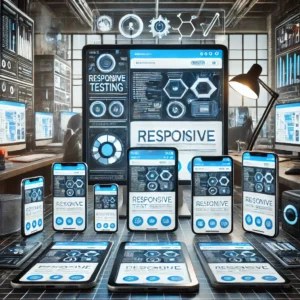Overview
Web applications are accessed mostly by different devices for easy access. This really demands a good user experience so that users do not get frustrated and switch to competitors. To have this in place, web device testing has a very important role that checking how well the web applications actually work on different types of devices, including smartphones, tablets, etc. In this article, we will explore web device testing in detail and outline the different tools and techniques used to perform web device testing.
What is Web Device Testing?
Reviewing the performance of applications on different devices like smartphones and tablets is called web device testing. It is done to ensure a pleasant user experience, regardless of the device being utilized. This testing assesses factors like screen size, resolution, device type, operating systems, and OS versions.
Testing on different devices helps find compatibility issues early in software development, allowing for quick fixes.
Key Aspects of Web Device Testing:
- Devices have different screen sizes and resolutions, which can make software applications look different. Web device testing ensures that the layout and content of the software are displayed correctly on all screens.
- Web device testing also checks how well the software performs on different devices. This includes looking at processing power, memory, and network conditions.
- By conducting web device testing, you are able to verify the software application’s compatibility with various operating systems.
Why Web-Device Testing Matters
With the smartphone market booming, it has become essential to test web applications on various popular devices before launching them. Device fragmentation means numerous mobile devices exist, each varying in screen size, resolution, operating systems (Windows, iOS, Android, Linux), OS versions, browsers, memory, processors, and more.
Testing web apps across this diverse range of devices can be daunting. However, ensuring cross-platform compatibility is crucial for any organization aiming to deliver a robust software application that attracts a wider audience.
Typically, developers create and conduct unit tests on a limited selection of devices. It falls upon testers to ensure the application functions correctly on the most commonly used devices in the market. Therefore, testing on the appropriate mobile devices is vital for achieving web-device compatibility.
Websites are constructed using various technologies like HTML, JavaScript, CSS, and PHP. Each browser employs a distinct engine for rendering HTML pages—Chrome utilizes Blink, Firefox operates on Gecko, and Safari runs on WebKit. Through web-device testing, testers must confirm that the functionality and user experience remain consistent, even if the user interface may differ slightly in some instances.
Tools for Web Device Testing
Different web device testing tools can be used to perform web device testing:
LambdaTest
It is an AI-powered platform that simplifies the process of conducting manual and automated tests at scale. You can seamlessly test your web applications with over 3,000 real devices, browsers, and operating systems available for access. It is recognized as a leading platform for cross device testing and is compatible with a range of testing frameworks such as Selenium.
Key Features
- Automated Testing: Run your tests using different programming languages on a vast online browser farm with over 3,000 real desktop and mobile environments.
- Real-Time Testing: Enjoy cross-browser testing on a Real Device Cloud for immediate feedback.
- Fast Automation: Speed up your testing process with HyperExecute, a next-gen cloud for quick end-to-end test orchestration.
- Testing at Scale: Use an open-source platform for test selection and flaky test management, helping you accelerate testing and get faster feedback on code changes.
- Visual Regression Testing: Identify visual differences with smart testing tools on the cloud.
- Third-Party Integrations: Connect with 120+ tools for CI/CD, project management, and codeless automation.
- Localhost Testing: Test your web and mobile applications on your local server.
- Geolocation Testing: Check your applications across 53+ locations worldwide.
- LT Browser 2.0: Use this Chromium-based tool for quick responsive testing with 50+ pre-installed device viewports.
Ranorex Studio
Ranorex Studio is a tool that is easy to use for web-device testing. It is filled with various features, such as integration with Ranorex Web Test, enabling users to conduct web scraping and functional testing. You can, for example, scrape all the links in your browser automatically and generate tests using the titles or text of those links.
Appium
Appium is a free tool for automating the testing of Android and iOS applications. It is ideal for evaluating web and mobile applications, particularly hybrid apps. By using Appium, you can automate functional testing, which enhances the overall performance of your mobile applications.
Espresso
Espresso is a popular testing framework designed for Android applications. Developed by Google, it simplifies writing UI tests for your apps. With a rich set of APIs like ViewMatchers and ViewActions, Espresso allows you to perform various user interactions and assertions effortlessly.
TestComplete
TestComplete is a powerful tool for web browser testing, automating compatibility checks across different configurations and operating systems. It effectively handles dynamic web elements and supports over 500 built-in controls and third-party frameworks.
Endtest
Endtest is an intelligent test automation platform that lets you create end-to-end automated tests easily. It supports automated web-device testing, access control, and parameterized testing. You can even test your application using IP addresses from various locations with Endtest’s geolocation testing feature.
Techniques of Web Device Testing
Here are some effective techniques you can use for web-device testing:
Using Physical Devices
When referencing physical devices, we are specifically talking about the tangible smartphones and tablets you physically handle, not the emulated or simulated versions used for testing. These devices are available in a variety of sizes, operating systems, hardware specifications, and forms like foldable phones and wearables.
Using physical devices has some clear benefits. They can support features that virtual devices might not, such as cameras, sensors, GPS, facial recognition, accelerometers, and more. This means you can better identify usability issues and ensure your app works well in real-world conditions.
However, testing on physical devices might not always be the best choice for minor functionalities. For instance, it seems impractical to buy an iPhone just to check if your app opens without crashing. You need to weigh the pros and cons of relying on physical device testing, especially if you have limited time and budget constraints.
Emulators and Simulators
For quicker testing, consider using Android emulators and iOS simulators. These tools allow your testing team to run tests on virtual devices, which can be faster and easier than setting up real hardware.
An emulator acts like another computer system, allowing your host machine to mimic the software and hardware features of an Android device. It creates virtual instances that simulate near-native capabilities, letting you adjust settings like battery state and geolocation.
Testing iOS applications can be tricky without an iPhone, iPad, or Mac. That’s where simulators come in—they create an environment that mimics the configurations and behavior of actual iOS devices. Running on a Mac, a simulator behaves like a typical application while simulating iOS devices.
However, be aware that emulators and simulators may not fully account for real user conditions, so some scenarios could be overlooked during testing.
Real Device Cloud with LambdaTest
The first two approaches can sometimes be time-consuming, expensive, and not entirely reliable. To ensure your application runs smoothly across various devices—including different desktop screen sizes, Android phones and tablets, iOS devices, and Windows—investing in a device cloud platform is often the best choice.
LambdaTest is a cloud-based web and mobile testing platform that gives you access to over 3,000 real devices and browsers for comprehensive testing. With LambdaTest, you can efficiently test your mobile applications across multiple devices and web applications across different desktop and mobile browsers—all without the need for any virtual machine setup.
How To Perform Web Device Testing
Here are the steps that you can follow for Web Device Testing
- Define Your Testing Goals
Start by figuring out what you want to achieve with your testing. Are you checking for compatibility, usability, or functionality? Also, decide which devices and browsers you will test on.
- Choose Your Testing Tools
Select tools that will help you with device testing, such as LambdaTest and Responsive Design Checker.
- Create Test Cases
Develop test scenarios that cover important functions, like navigation, form submissions, and media playback. Make sure to include different user interactions for each type of device.
- Conduct Testing
Manual Testing: Visit your website on various devices and browsers. Look for layout issues, functionality, and overall user experience.
Automated Testing: Use automation scripts to run repetitive tests across different devices and browsers for better efficiency.
- Check Responsiveness
Make sure your layout adjusts correctly across different screen sizes (mobile, tablet, and desktop). Test media queries and responsive design elements to ensure everything displays properly. You can take help from the responsive checker by LambdaTest.
- Verify Browser Compatibility
Ensure your website works well on different browsers, such as Chrome. Check specific features, like JavaScript functions and CSS properties, as these can behave differently depending on the browser.
- Assess Performance
Monitor how quickly your pages load on various devices. Use tools like Google PageSpeed Insights or GTmetrix to evaluate performance.
- Gather Feedback
Collect feedback from users who test your site on different devices to find usability issues. You might consider using surveys or conducting usability testing sessions to gather valuable insights.
- Document Your Findings
Monitor any problems discovered, documenting them with screenshots and instructions for reproducing them. Rank these concerns according to their severity and impact on the user’s experience.
- Retest After Fixes
After fixing any issues, retest the affected devices and browsers to make sure everything works correctly now.
- Keep Testing Regularly
Set up ongoing testing strategies to stay updated with changes in web standards, new devices, and shifting user behaviors.
Best Practices for Web Device Testing
To optimize your web-device testing process, follow these best practices:
- Identify Your Testing Devices
Start by determining which devices you’ll test. Use tools like Google Analytics to see what devices your visitors use, and consider running user surveys for direct feedback.
- Define Your Testing Scope
Understand the features that matter most to your users and specify the devices and operating systems you need to test. Create a clear test plan outlining your strategy.
- Combine Emulators with Real Device Testing
While emulators and simulators are useful, always complement them with testing on actual devices to capture the real user experience.
Conclusion
In this article, we have learned about web device testing. Here are the key takeaways. Ensure your app is tested on a mix of devices, including older models, to cover all user bases. Test your app on various network conditions, including Wi-Fi and slower connections, to ensure it performs well everywhere. Make testing an ongoing process to catch and fix bugs early. Consider automation tools to save time and streamline your testing.







